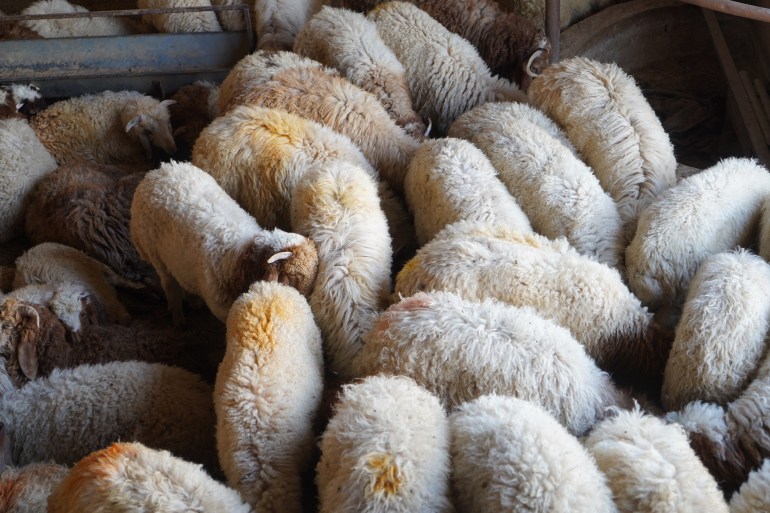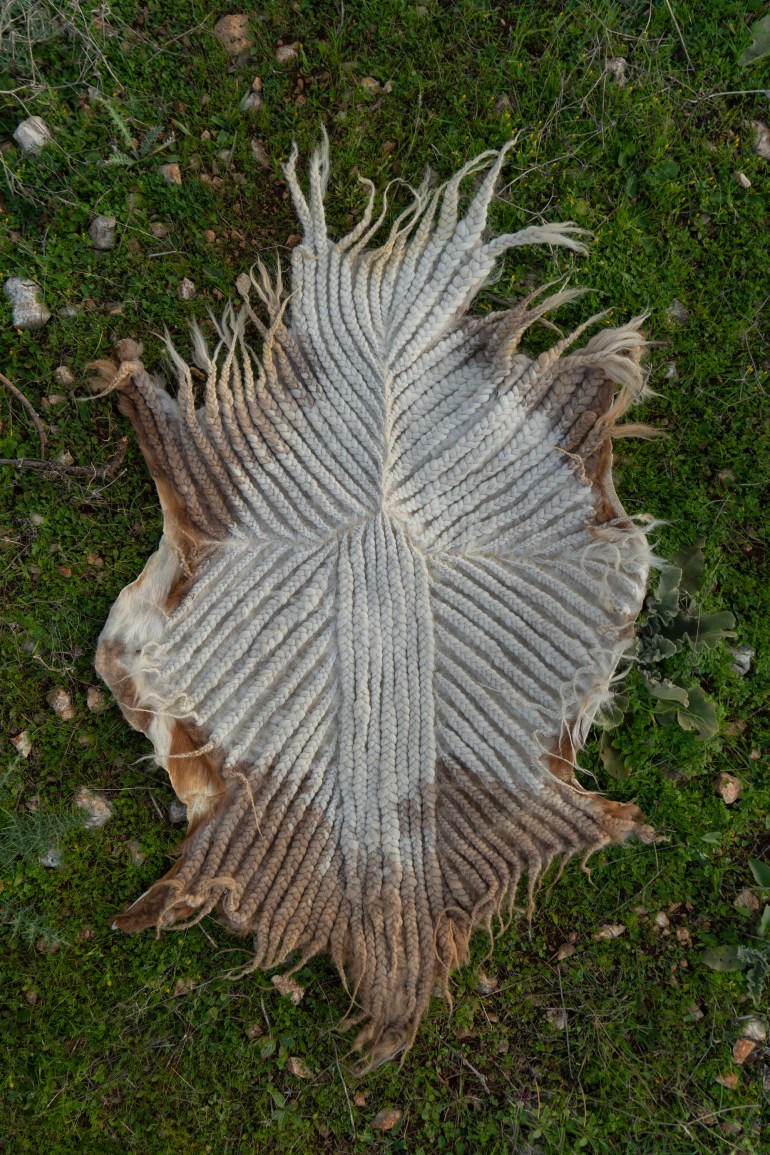Shortages of raw materials are impacting many sectors of Lebanon’s crisis-ridden economy. But two things it has in abundance are grazing pastures and Awassi sheep.
Indigenous to Lebanon, Awassi sheep produce lots of wool – tonnes of which are thrown away each year, the United Nations reckons.
It wasn’t always that way. Lebanon’s wool and textile industry thrived from the 1970s until the turn of the century, but wars abroad and cheap imports from China roiled the once-healthy trade.
Now, all industries in Lebanon are trying to stay afloat in the midst of a two-year-old economic crisis that has seen inflation soar, foreign exchange reserves dry up and citizens take to the streets to protest successive government failures to stem the carnage.
But in the Bekaa Valley, a small women’s cooperative isn’t waiting for the government to help. They’re taking matters into their own hands and using discarded Awassi wool to weave handcrafted rugs with an eye towards earning much-needed export revenue while creating a more sustainable local economy.
From thriving to foundering
Lebanon used to export textiles to Syria, Iraq, Jordan, Egypt, Libya and the Gulf, independent economist Elie Yachoui told Al Jazeera. But that trade foundered after the administration of late Prime Minister Rafik Hariri lowered customs duties on textiles from 35 percent to 5 percent in 2000, flooding the local market with less expensive substitutes that crushed the domestic textile and wool industry, which Yachoui said supported at least 100,000 families.
“Lebanon had about 10 yarn factories, about 200 textile factories, 15 dye factories and hundreds, if not thousands, of factories that produced clothing,” said Yachoui. “After the customs changes, everything closed. They couldn’t compete with Chinese imports and sold all the machines to Syria or some moved to Egypt.”
With no factories to supply in Lebanon, shepherds in the Bekaa Valley started exporting almost all their raw Awassi wool to Syria for processing – until war broke out there in 2011, shuttering or destroying factories in Aleppo and unleashing sanctions that prohibited trade with Syria.
 Indigenous to Lebanon, Awassi sheep produce lots of wool – tonnes of which are thrown away each year [Courtesy of Adrian Pepe]
Indigenous to Lebanon, Awassi sheep produce lots of wool – tonnes of which are thrown away each year [Courtesy of Adrian Pepe]While UN Comtrade data shows little change in Lebanon’s textile exports over the last 10 years, Yachoui said the local Awassi wool trade was not captured by the metric. The only indicator that something had changed was the lack of any official textile exports to Syria after 2014, due to the conflict.
“Shepherds used to pack their wool into a pick-up truck and smuggle it across the border, sell it directly to the factories. None of this registered, but that was how all the local wool would get to Syria,” Yachoui said. “All the wool that is exported to the rest of the world is likely imported wool from other places because we have triangular trade in Lebanon, so they will be importing foreign wool and selling it on to other countries.”
But the Bekaa Valley’s wool production is getting a kick-start from Bisat al Rih, an Aarsal-based women’s cooperative that makes carpets using Awassi wool.
Founded by Halima Al Hojairy, the cooperative aims to provide work – and a steady source of revenue – for local women and to keep Lebanon’s traditional crafts alive by passing on the skills she learned from her family.
“I wanted to help local families in the Bekaa and create a small market for the sheeps’ wool that piles up in the village and surrounding areas,” Hojairy told Al Jazeera. “We’re trying, as a cooperative, to create a market for this wool again, finding products to make from it and telling people to buy directly from the shepherds.”
 Women from Bisat al Rih weaving a wool carpet [Courtesy of Adrian Pepe]
Women from Bisat al Rih weaving a wool carpet [Courtesy of Adrian Pepe]Currently, the cooperative uses roughly 250kg of Awassi wool per year. But Hojairy is hoping that the co-op will expand its production along with sales – both abroad and at home.
The Lebanese pound has lost more than 90 percent of its value against the United States dollar over the past two years, but that makes Lebanese exports like woolen rugs more competitive. And though most people in Lebanon have little cash to spare on home furnishings, Hojairy is betting that those who do have the funds to spruce up their homes will gravitate to more affordable locally made goods.
“If we worked on this, we could find a way to make a market around this again,” said Hojairy, adding that the market would not only benefit livelihoods, but the environment as well. “It takes a long time [for discarded wool] to disintegrate,” she says, “and it pollutes the landscape, too.”
Artisanship and possibilities
Textile artist Adrian Pepe has been working with Bisat Al Rih on a project that aims to showcase possible uses for local raw materials like Awassi wool. During the initial round of coronavirus pandemic lockdowns last year, Pepe spent months in Aarsal getting to know the local shepherds and learning about the excess wool left to wither every year.
He recently showed a series of carpets he made with salvaged Awassi wool at a Dubai Design Week exhibit titled Entangled Matters.
The rugs use several wool materials, tracing the evolution of textiles from sheepskin to felt – the earliest known textile – to spun wool knitted into fabrics and embroidery.
 One of Adrian Pepe’s carpets made with Awassi wool, a design he hopes will inspire other creators to follow his lead [Courtesy of Adrian Pepe]
One of Adrian Pepe’s carpets made with Awassi wool, a design he hopes will inspire other creators to follow his lead [Courtesy of Adrian Pepe]“In the past, [Lebanese wool] couldn’t compete against international wool standards, because the material is a little rough, and then synthetic materials became cheaper than the natural material,” he told Al Jazeera. “Now, with the dollar rate affecting imports, the local wool is cheaper, but no one knows about it.”
Pepe said the exhibit is designed to inspire other artisans to use Awassi wool by showcasing “the breadth of possibilities with the material itself”.
“It’s the first step into that commercial space and for me, that’s very important,” he said.
Pepe is also working on a more practical use for felt made with Awassi wool, teaching women at Bisat Al Rih how to make felt – a skill they plan to apply renovating 300 tents at a Syrian refugee camp near Aarsal.
But economists say that in order for nascent efforts to breathe life back into Lebanon’s wool export trade – as well as other productive industries – the government must create a nurturing environment by avoiding past policies that decimated local producers.
“Encouraging local production rests on raising customs tariffs to protect local products, giving tax incentives to local producers, subsidising as much as possible raw material imports, and promoting local products abroad while concentrating on high-value products, [such as] food products, vegetables and jewelry,” Group Chief Economist and Head of Research at Bank Audi Marwan Barakat told Al Jazeera.
"artist" - Google News
December 17, 2021 at 08:00PM
https://ift.tt/3IVfXCn
How a co-op and an artist plan to revive Lebanon’s wool trade - Al Jazeera English
"artist" - Google News
https://ift.tt/2FwLdIu
Bagikan Berita Ini














0 Response to "How a co-op and an artist plan to revive Lebanon’s wool trade - Al Jazeera English"
Post a Comment